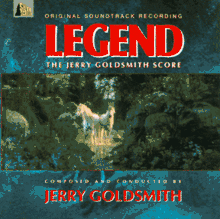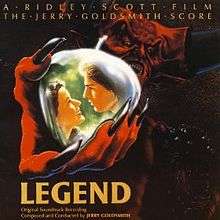Legend (film score)
Legend: The Music of Jerry Goldsmith is a musical film score by American composer Jerry Goldsmith, released in 1986 for the worldwide release of the film of the same name, (excluding the US). The album was released on compact disc in 1992 through Silva Screen records and featured alternate cover art and additional songs.[2][3][4][5]
| Legend | |
|---|---|
 | |
| Soundtrack album by | |
| Released | 1986 (Vinyl) 1992 (CD) |
| Recorded | 1985 |
| Genre | Classical, orchestral |
| Length | 46:06 |
| Label | Up-Art |
| Compact disc versions | |
 | |
| 2002 Reissue | |
 | |
| Review scores | |
|---|---|
| Source | Rating |
| Allmusic | |
| Filmtracks.com | |
Background
Goldsmith's score was featured in the original version of the film, but due to a disappointing test screening with the original orchestral score, director Ridley Scott decided to make changes to the film. Sidney Sheinberg, president of MCA (the parent company of Universal at the time), felt that the Goldsmith score would not appeal to the youth and pressed Scott for a new score. German group Tangerine Dream was contracted to complete a new, more contemporary score—-a job they completed in three weeks. Until 2002, only European audiences could see Legend with Goldsmith's score.
Track listing
| No. | Title | Length |
|---|---|---|
| 1. | "My True Love's Eyes/The Cottage" | 5:02 |
| 2. | "The Riddle" | 3:40 |
| 3. | "Sing the Wee" | 1:06 |
| 4. | "The Goblins" | 3:41 |
| 5. | "The Dress Waltz" | 2:44 |
| 6. | "The Ring" | 6:29 |
| 7. | "The Unicorns" | 7:53 |
| 8. | "Bumps and Hollows" | 5:03 |
| 9. | "Forgive Me" | 5:11 |
| 10. | "Reunited" | 5:17 |
| No. | Title | Length |
|---|---|---|
| 1. | "Main Title/The Goblins[lower-alpha 1]" | |
| 2. | "My True Love's Eyes[lower-alpha 2]/The Cottage" | |
| 3. | "The Unicorns" | |
| 4. | "Living River[lower-alpha 1][lower-alpha 2]/Bumps and Hollows[lower-alpha 2]/The Freeze" | |
| 5. | "The Faeries[lower-alpha 1]/The Riddle" | |
| 6. | "Sing The Wee[lower-alpha 2]" | |
| 7. | "Forgive Me" | |
| 8. | "Faerie Dance[lower-alpha 1]" | |
| 9. | "The Armour[lower-alpha 1]" | |
| 10. | "Oona*/The Jewels[lower-alpha 1]" | |
| 11. | "The Dress Waltz" | |
| 12. | "Darkness Fails[lower-alpha 1]" | |
| 13. | "The Ring" | |
| 14. | "Reunited[lower-alpha 2]" |
- Contains previously unreleased material
- Lyrics by John Bettis